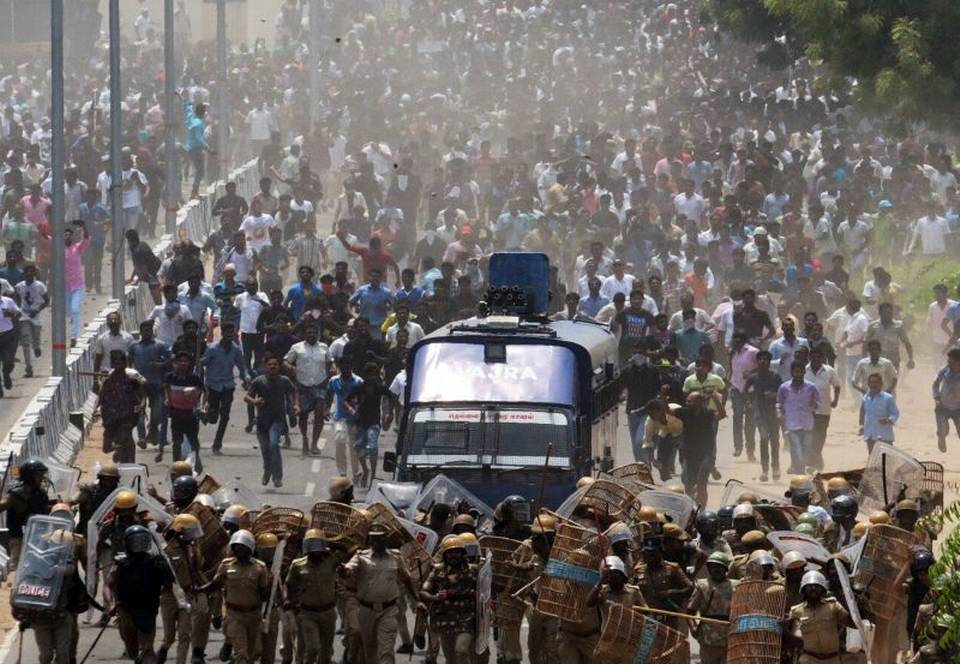Editor’s Note: FII’s #MoodOfTheMonth for July 2021 is Sustainability. We invite submissions on the diverse aspects of sustainability throughout the month. If you’d like to contribute, kindly email your articles to sukanya@feminisminindia.com
Approving developmental projects at the cost of our environment is not new, neither are the protests in response to such decisions, nor the brutality that follows.
From Amrita Devi and others in the Bishnoi community who sacrificed their lives protesting against the felling of trees, to the 500 tribal protestors booked by the police for violating Covid protocol while protesting against harmful chemicals dumped into the river by an industry making the water unsafe, incidents like this have happened and are still happening.

A graph from the data provided by EJAtlas, an organisation that documents the conflicts within environmental movements shows the intensity of violence in this respect in India, in comparison to the world. There are frequent instances of high-intensity cases of brutality caused by developmental projects contingent to the displacement or destruction of local communities.
High-intensity violence as a response to environmental movements clearly comes as no surprise, but one incident particularly shook me. – The Thoothukudi Massacre.
The Thoothukudi Massacre: A timeline of events
Sterlite Copper, a copper smelter plant owned by Vedanta Ltd. started its operations in the Tuticorin district or Thoothukudi in Tamil Nadu after being asked to suspend its operations in Maharashtra. It was operating at 4,00,000 tonnes per year and protests erupted in response to the plant’s plan to increase capacity to 8,00,000 tonnes per year.

1994 – A No Objection Certificate was issued by the Tamil Nadu Pollution Control Board (TNPCB) and the company was asked to assess the environmental impact in tandem with EIA (Environment Impact Assessment) protocols
1995 – Environment Clearance was given to the company without the EIA with a caveat that it has to be built 25km away from the Gulf of Mannar, which was later violated and the plant was located within 14km
1996 – The Tamil Nadu Pollution Control Board (TNPCB) issued them license to operate
1997 – People in the vicinity of the plant complained of various medical problems like fainting, vomiting, and headaches due to an SO2 gas leak from Sterlite and over 90 of them were hospitalised.
1998 – National Environmental Engineering Research Institute (NEERI) found that levels of certain chemicals like Selenium, Arsenic, and Lead were higher than their safety limits but they also gave a clean chit despite knowing this. Birds died after consuming the water mixed with effluents from the plant
In May, violence broke out during the protests and the police started shooting at the protestors without a formal warning. 13 people died in the firing
1999 – There have been protests since then in hopes of shutting down the plant which has been causing health problems, polluting the water and soil
2006-2007 – A health status and epidemiological study was carried out by the Tirunelveli Medical College around a 5km radius of the plant
2008 – Their report suggested that there was an increase in respiratory diseases, ENT morbidity, body pain, and menstrual disorder among people in that vicinity
2010 – An NGO found a high salinity level, exceeding the prescribed limits by 2000 mg/L which can damage the crops
2017 – A scientific study found that groundwater samples contained higher levels of heavy metals exceeding the safety limits
2018 – Hunger strike was organised in response to Sterlite’s plan to increase its capacity to 8,00,000 tonnes per year. Many people were arrested but that did not deter the protestors. Thousands of people demanded the plant to be closed.

However, Sterlite responded saying that its emissions were low. Shops were closed down in protest. Sterlite alleged the possibility of violence amidst the demonstrations and moved to the Madras High Court for the imposition of Section 144, declaring the gathering of more than 4 people unlawful.
Also read: Police Brutality: Now A Common Sight In India
In May, violence broke out during the protests and the police started shooting at the protestors without a formal warning. 13 people died in the firing. The next day, the Madras High Court ordered the closure of the plant. Section 144 was imposed, which was revoked 13 days after the violence. Another injured survivor from the protest who was in a coma, passed away in October, increasing the death toll to 14.
All of the 14 people who died in the thoothukudi protests have names and their own stories. And of course, must always remember the police brutality, Sterlite Copper, and all those who approved the project
After the closure of the plant, a report found that the sulphur dioxide levels have dramatically decreased, and another report stated that the air quality has shown significant improvement.

Remembering the deceased: Not mere numbers, but names with stories of their own
All of the 14 people who died in the Thoothukudi protests have names and their own stories. Remembering 17-year-old Snowlin, the youngest of them who was an aspiring lawyer.
Remembering Ranjith Kumar, a 21-year-old who was a state-level boxer and wanted to become a professional boxer. Remembering Justin who passed away after being in a coma for 5 months due to the injuries caused during the lathi charges at the protest. Remembering Glaston, a 39-year-old fisherman, whose daughter quit practicing Judo because her dad is no more there to help her.

Remembering 55-year-old Kanthaiya, who is survived by his wife and son, who cannot fend for himself since he has special needs. Remembering Anthony Selvaraj, a 43-year-old who was not even there for the protest – he was out to invite his friends for his daughter’s coming-of-age ceremony.
Remembering the 47-year-old Jancy Fernando who was shot when she was on her way to bring some spicy fish curry for her daughter. Remembering Jeyaraman, Karthi, Shanmugam, Tamilarasan, Maniraj, Selvasekar and Kaliappa who also lost their lives during the shooting.
And of course, must always remember the police brutality, Sterlite Copper, and all those who approved the project.
Also read: Why Is Making Environmental Policies During A Pandemic Unethical?
Maithri is a computer science student and like the cliché of an engineering student always doing something other than engineering; she enjoys reading, learning and writing about the environment & technology. You may find her on Instagram and LinkedIn
Featured Image Source: Wikipedia




